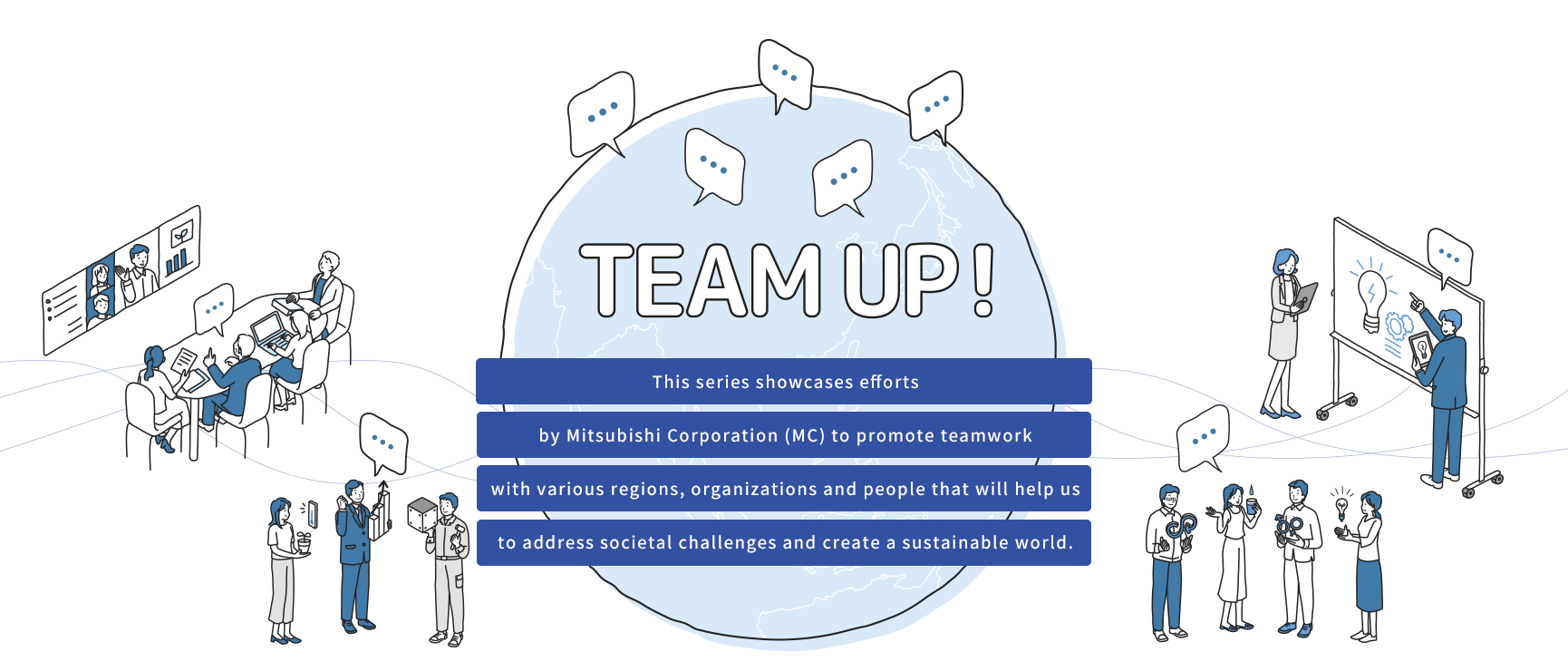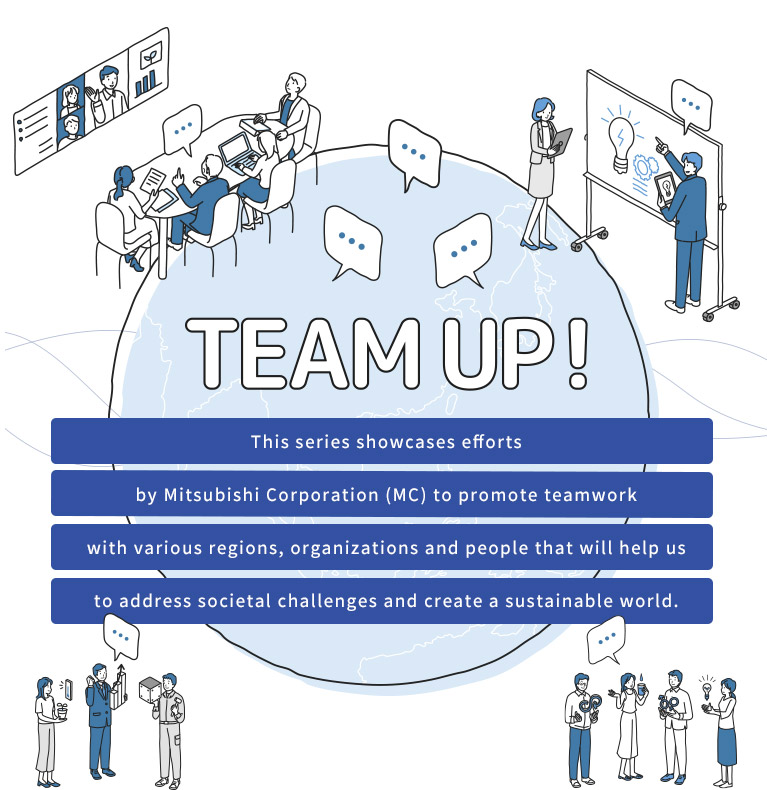TEAM UP for a Sustainable World:Pooling Our Talents to Help Realize Global Sustainability


Teaming Up with Local Authorities to Create a New Mobility Service TEAM UP for a Sustainable World

The AI-driven On-demand Bus Service "KnowRoute" (2)
In March 2021, the "KnowRoute" on-demand bus service was launched in Munakata City, Fukuoka Prefecture. Why has the city chosen to adopt this new service, and exactly how has it made it work? Our next two articles feature a roundtable discussion between members of the project team from Munakata City, MC and Nishi-Nippon Railroad Co., Ltd. (Nishitetsu). They reflect on how the business got started and how it has evolved over the last few years.
- Roundtable Participants
-
Hiroshi Takasaki (Head of Urban Redevelopment, Munakata City)
Tadaharu Uchida (Deputy Head of Urban Redevelopment, Munakata City)
Takehiro Fujioka (Next Mobility EVP, CSO; on secondment from MC)
Hirofumi Matsumura (Next Mobility Operation Manager; on secondment from Nishitetsu)
Kenichi Akimoto (Next Mobility Sales and Business Planning Manager; on secondment from MC) - Interviewer
- Takashi Horiuchi (GLOBE+ Editor in Chief)
Abolishment of Existing Fixed Route Bus Service Jeopardizes Citizen's Mobility
—— How did the "KnowRoute" service get started in Munakata's Hinosato District? Can you give our readers a bit of background on the region and how this project came to be?
Takasaki
Sure. Munakata City is a bedtown that lies midway between the cities of Fukuoka and Kita-Kyushu. Its population is roughly 97,000 people. In the late 1960s, the city began making good progress developing residential and commercial complexes, and Hinosato Danchi is a case in point. In fact, back then it drew attention for being one of the largest in western Japan. Unfortunately, in the fifty-some years since then, the city's population has continued to age, and it has actually been declining over the last decade or so.
Recently, we have been taking steps to redevelop both these complexes and the city of Munakata itself. Little by little, we're seeing young people come back to the area, and its population has more or less stabilized.

Uchida By the spring of 2020, the Hinosato District had two Nishitetsu bus routes, but the decision was made to abolish them at the end of March 2021. This left local residents with no means of public transportation, so the city officials knew that they had to think about a replacement service. We did discuss using community buses, which were already running in other parts of the city, but those wouldn't have been convenient for the Hinosato District. We then learned of the "KnowRoute" service from a newspaper advertisement, so we reached out to MC to find out more about it.
—— When jurisdictions adopt new public transit systems, they need to work things out with a lot of different stakeholders, such as taxi companies, transportation authorities, and local citizens. How did you manage to do that?
Fujioka The "KnowRoute" business is being developed by Next Mobility, a company that is jointly owned by MC and Nishitetsu. The latter has a very strong presence in Fukuoka, so we have been relying on its experts to assist our negotiations with the prefectural municipals, local taxi companies, and so on. Once all of the concensus buliding among stakeholders have been made, Next Mobility will be in charge of procuring the buses, training the drivers and staff, and setting up all of the systems.
Matsumura One thing we have stressed in our talks with the taxi companies is that an on-demand bus service would not be their rival, but rather their ally in protecting local citizen's mobility and promoting the use of public transportation. Our goals are aligned, so there is no reason why we can't co-exist. Furthermore, an on-demand bus service can even create new business revenues for taxis. Some of the drivers who are currently working for "KnowRoute" are actually employed by the taxi companies.
Winning Over Local Residents
—— How have the locals been reacting to the new service? What has been your focus in communicating its merits to them?
Uchida When Nishitetsu reported that it would be discontinuing its bus routes, we immediately held a hearing with members of the local community regarding alternative means of transportation. The concept of an on-demand bus service was completely new to them, so naturally they voiced a number of concerns, such as buses not arriving even if they waited at bus stops, and whether they would always have to make a reservation whenever they wanted to use the service. The best way we could think of answering their concerns was to let them actually experience the service for themselves, so we took Hinosato District's community officials to Fukuoka's Island City, where it was already up and running.

Fujioka There were about 20 officials who came with us, and most of them were fairly elderly, in their 70s and 80s. I remember how skeptical they looked when we met up with them at the meeting room before embarking for Island City, but later on, after they had ridden the buses, their attitudes changed. They were pleasantly surprised by how easy and convenient the system is.
Uchida Those officials spoke to the other residents about the system's benefits, and before long word began catching on. Looking back, I think that allowing them to share and pass the information along between themselves was a better way to promote the service than having city officials like ourselves try to explain it to them unilaterally. The result was that most of the local residents came to understand and appreciate what "KnowRoute" could offer them.
—— Were there many hurdles to getting people to download the app and register themselves as users?
Matsumura
Before we actually sent out the buses, we held a launch ceremony, which even the mayor of Munakata City attended. We also took citizens on test runs and worked hard to raise awareness about the service. But despite all of our efforts to promote it, we knew that getting everyone to trust it was going to be another challenge altogether.
To address that, Munakata City hosted a number of seminars to go over how everything would work. After explaining the app, we encouraged those in attendance to book rides for after the seminars that would drop them off close to their homes. So in other words, we didn't just explain the service, we also got everyone to try using it right then and there.
We took other steps to make the service more accessible too, such as having a coupon promotion for newly registered users.

One thing that really impressed me was that some residents came to more than one of the seminars that were held to explain the app. They asked about things that they hadn't understood during the first seminar and about what they should do in certain situations. I think that most of them had positive feelings about the service and wanted to get accustomed to using it.
Keys for getting a New Mobility Service to Take Root
—— Challenges like regional transportation are being faced by local authorities all across Japan, but even when a possible solution is presented, it's never easy getting everyone to act on it. Why do you think Munakata City was able to pull this off?
Uchida
It's been about 50 years since work began in the city to develop large-scale, residential and commercial complexes, and over that time, it has become more and more clear how an aging, dwindling population is going to pose problems for this municipality in the future. Both its officials and its residents have been feeling a sense of crisis, because they know that the city will simply not survive unless something is done. In 2013, the officials formed a project team for complex redevelopment, which kicked off joint efforts with citizens to rebuild the city with an eye to the next half century.
A big plus for this city is the fact that those who live and work here have always shared a powerful affection for it. They have many happy memories and connections here, and I think that even the "KnowRoute" service has benefitted from that.

Fujioka
The city officials took a big risk when they decided to adopt the service, because it meant taking a chance on something relatively unproven. At the time, there were few successful examples in Japan of an AI-powered, on-demand bus service. But I think there are a couple of reasons why the officials were able to take the plunge. The first was that they had very clear vision and foresight, and the second was their keen awareness of the problems the city was facing.
Another thing worth mentioning is that for any new service to take root, it needs strong buy-in from not just the local government, but the local community as well. Obviously the young people in Munakata City have been open to new ideas, but so too have the older folks, and that makes a massive difference in my opinion.
Positive Feedback, but Challenges Remain
—— It has now been about a year since the trial runs of "KnowRoute" got underway. What have you learned so far and what future issues are you anticipating?
Akimoto When we launched the trials in March 2021, we were getting about 50 passengers a day, but that number surged when the service went into full swing the following month. Passenger numbers have continued to climb since then, and now our two buses are carrying between 120 and 180 passengers between them on weekdays. There were certainly mixed feelings of expectation and apprehension when we started, but I think that the service is now operating well.
Takasaki Users have been delighted with how convenient the service is, and not a day goes by when I don't catch sight of one of the buses. How can anyone say that a system capable of picking you up just minutes after you call and delivering you to your intended destination isn't user friendly? Before we rolled it out, some of the city's elderly residents were worried that they wouldn't be able to get used to using an app, but thanks to the friendly assistance provided by the people at Next Mobility, NPOs and the Munakata City offices, even those residents were able to master the app with no major difficulties.

Uchida We're still only halfway through our trial period, but the service has already pretty much taken root with the community. To boost our ridership even more, we're thinking about increasing the number of meeting points and tying the service in with events and tourism. One of the issues we're having to contend with is reducing our running costs.
Matsumura
Our aims were to get everyone who uses conventional, fixed-route buses to take advantage of on-demand buses and tap into new demand as well. In truth though, on-demand ridership at the heavy-commuter, 8 a.m. hour has fallen off a bit compared to that of fixed-route buses. We think that this is because arrival times of traditional mobility services tend to be fixed, and therefore a bit more reliable. On that point, there is certainly room for improvement, but our plan is to be even more proactive about growing our ridership, even with the pandemic still a cause for concern.
Children today will be adults in a few decades' time, and our hope is that "KnowRoute" will have evolved by then into their go-to option for mobility. With the help of the good people of Munakata City, that's the future that we're looking to make possible.
- * Part 2 of the roundtable discussion will be featured in Volume 3 of this series.
- * The interviews conducted for the purpose of this article were carried out in accordance with pandemic-related measures. Masks were only removed for photographs.
- The AI-driven On-demand Bus Service "KnowRoute" (1)
- The AI-driven On-demand Bus Service "KnowRoute" (2)
- The AI-driven On-demand Bus Service "KnowRoute" (3)



